COVERINGS OF THE OPTICAL TUBES OF MICROSCOPES:
SHARKSKIN, RAYSKIN, SHAGREEN, AND OTHER MATERIALS
-what are they and what is the difference?
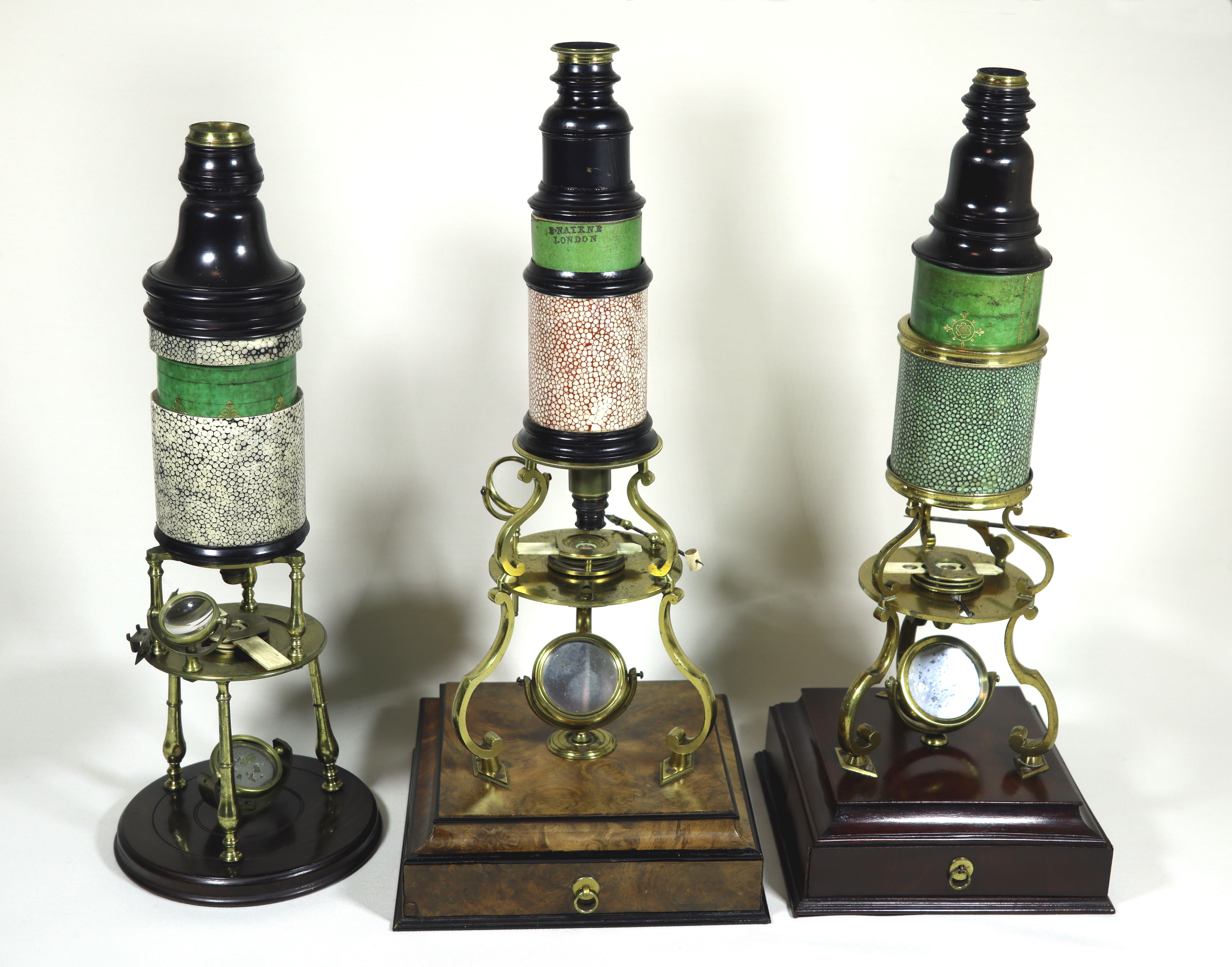
Three Shagreen-covered Culpeper-type Compound Microscopes:
Left:By Edmund Culpeper, with Gray Shagreen, circa 1760 (private collection).
Middle:By Edward Nairne, with Red Shagreen, circa circa 1770 (private collection).
Right: Maker unknown, with Green Shagreen, circa 1800 (private collection).
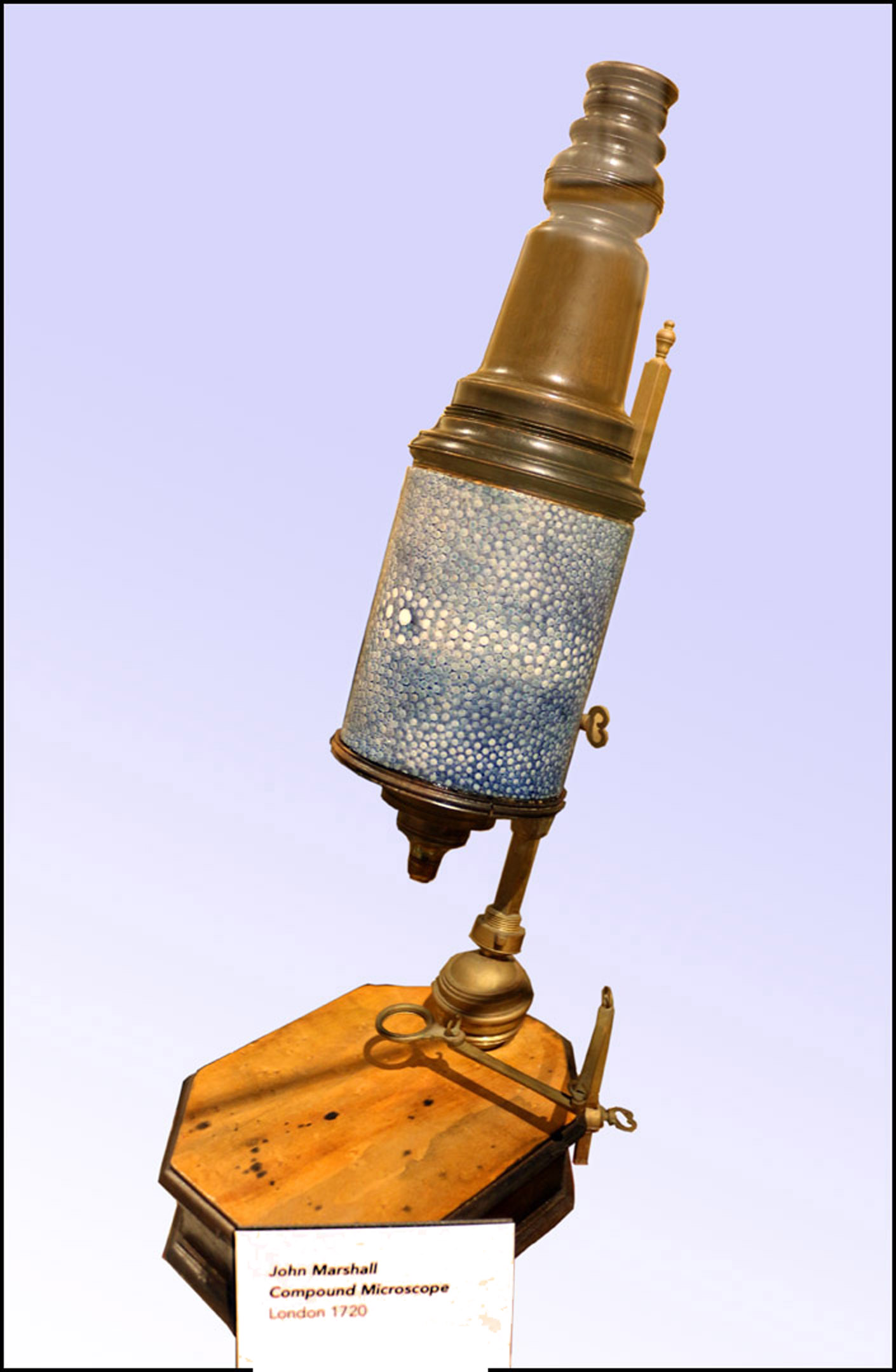 Although the material that was, in ancient times, referred to as shagreen was a pitted material made from rawhide(not leather), and sharkskin was also at one time referred to as shagreen, collectors today usually refer to a specially treated and polished form of stingray skin as Shagreen(above and left). This has a
Although the material that was, in ancient times, referred to as shagreen was a pitted material made from rawhide(not leather), and sharkskin was also at one time referred to as shagreen, collectors today usually refer to a specially treated and polished form of stingray skin as Shagreen(above and left). This has a pearly
pattern of little circles which vary in size on a single piece of the material. Shagreen of this type was particulary popular on microscope and telscope tubes of the late 18th and early 19th centuries. Shown on the three Culpeper microscopes shown above, and in close up views below, the skin on the optical tubes was usually dyed gray, with red being less common and green being less common, and blue, as seen to the left perhaps the rarest color. The cases for such microscopes were usually made of stained wood. 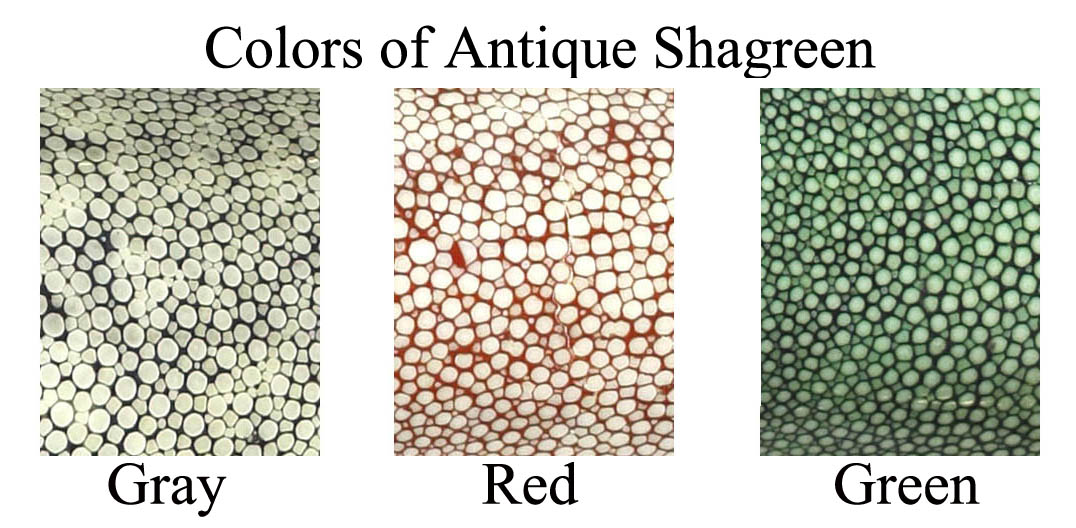
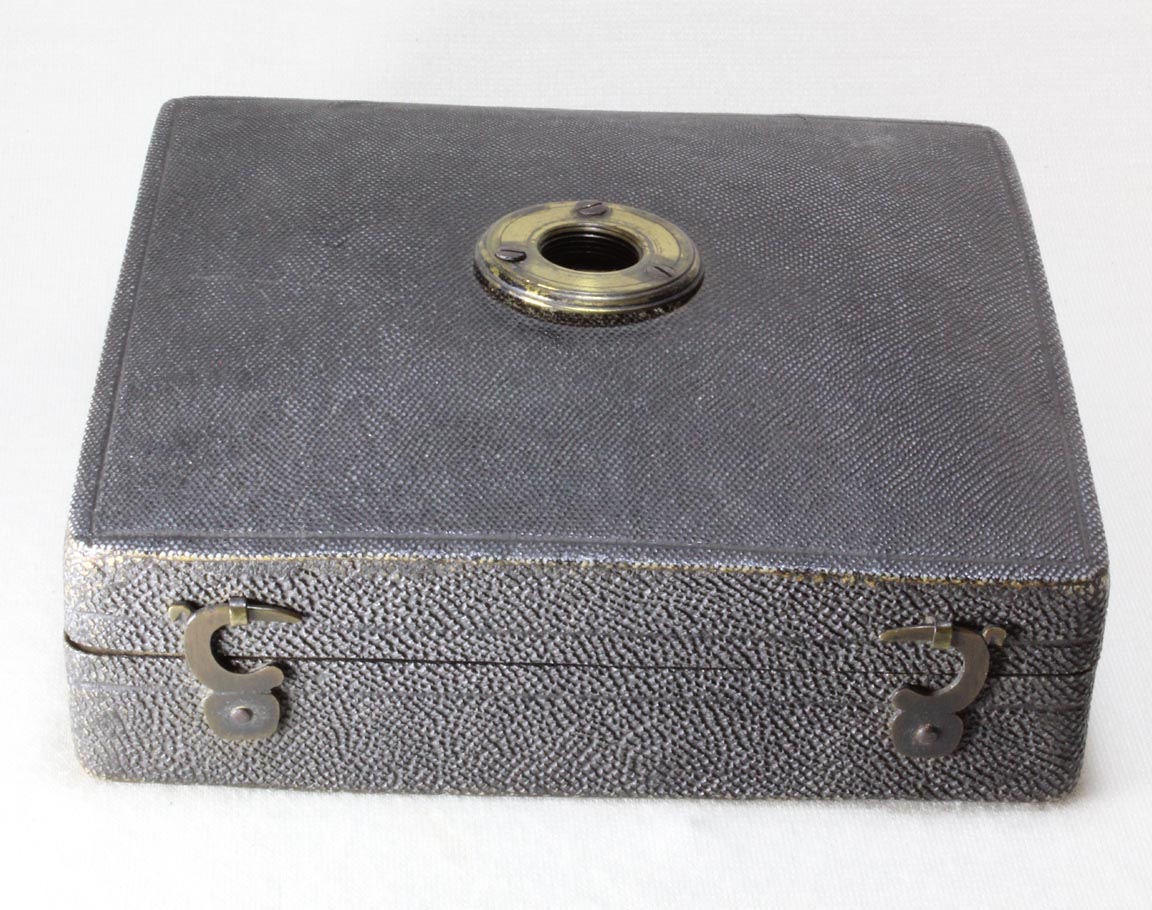 Unlike traditional Shagreen, sharkskin was often used by mid to late 18th century makers to cover the outside of the cases of microscopes; most of these microscopes were themselves usually made of lacquered brass. Unlike rayskin, sharkskin, used to cover the outside of a case, was not usually polished to smooth but rather left a little coarse. An example of this use can be seen on the cases of Ellis-aquatic type microscopes(right) as well as the cases for the instruments sold by Benjamin Martin and others.
Unlike traditional Shagreen, sharkskin was often used by mid to late 18th century makers to cover the outside of the cases of microscopes; most of these microscopes were themselves usually made of lacquered brass. Unlike rayskin, sharkskin, used to cover the outside of a case, was not usually polished to smooth but rather left a little coarse. An example of this use can be seen on the cases of Ellis-aquatic type microscopes(right) as well as the cases for the instruments sold by Benjamin Martin and others.
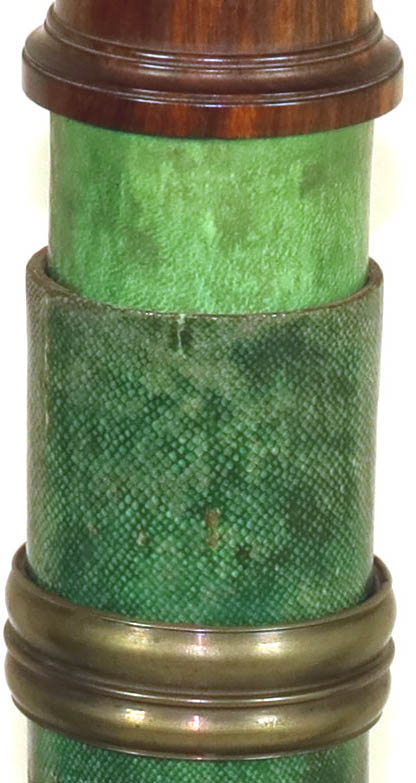 Rarely though, polished sharkskin resembling rayskin shagreen was used to cover optical tubes (left). Note the equally-sized smaller circles of this material as compared to rayskin shagreen.
Rarely though, polished sharkskin resembling rayskin shagreen was used to cover optical tubes (left). Note the equally-sized smaller circles of this material as compared to rayskin shagreen.
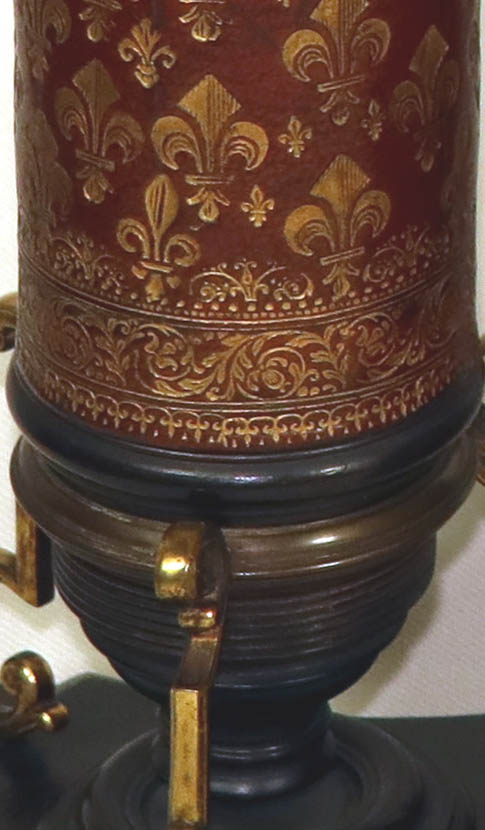 Another type of covering used for the bodies of antique microscopes included embossed leather(right). This practice became very uncommon after about 1800. The term 'tooled leather' includes all forms of three dimensional changes in leather. Embossing, also known as pressing, is a specific type of tooling of leather, though sometimes embossed leather is simply referred to as tooled leather. Carving of leather, another form of tooling, is not a form of modification seen on the covering of microscopes, though in rare cases, it may have been used for decoration of leather cases used to house microscopes. The example shown to the right, as in most cases, has gold leaf applied to the embossed areas. The patterns of these embossings can be used to approximately date a microscope, but not to identify a maker, since during any one time period the same patterns were supplied to most or all makers.
Another type of covering used for the bodies of antique microscopes included embossed leather(right). This practice became very uncommon after about 1800. The term 'tooled leather' includes all forms of three dimensional changes in leather. Embossing, also known as pressing, is a specific type of tooling of leather, though sometimes embossed leather is simply referred to as tooled leather. Carving of leather, another form of tooling, is not a form of modification seen on the covering of microscopes, though in rare cases, it may have been used for decoration of leather cases used to house microscopes. The example shown to the right, as in most cases, has gold leaf applied to the embossed areas. The patterns of these embossings can be used to approximately date a microscope, but not to identify a maker, since during any one time period the same patterns were supplied to most or all makers.
Some optical tubes were covered with vellum, often dyed, but these were usually the inner tubes, not the outermost tube; the optical tube of the microscope shown on the left is covered in dyed vellum, while the outer tube it slides in is made of polished sharskin dyed green. Vellum is a fine parchment made from goatskin. Very old books can be found with covers and or pages made of vellum.
The author would like to thank the owners and photographers of the microscopes seen on this page for allowing me to use them to illustrate this and other pages on this site.
For those interested in a more detailed history of the evolution of Shagreen(not the kind referred to on this page) see the page on a more general history of Shagreen.

 Although the material that was, in ancient times, referred to as shagreen was a pitted material made from rawhide(not leather), and sharkskin was also at one time referred to as shagreen, collectors today usually refer to a specially treated and polished form of stingray skin as Shagreen(above and left). This has a
Although the material that was, in ancient times, referred to as shagreen was a pitted material made from rawhide(not leather), and sharkskin was also at one time referred to as shagreen, collectors today usually refer to a specially treated and polished form of stingray skin as Shagreen(above and left). This has a 
 Unlike traditional Shagreen, sharkskin was often used by mid to late 18th century makers to cover the outside of the cases of microscopes; most of these microscopes were themselves usually made of lacquered brass. Unlike rayskin, sharkskin, used to cover the outside of a case, was not usually polished to smooth but rather left a little coarse. An example of this use can be seen on the cases of Ellis-aquatic type microscopes(right) as well as the cases for the instruments sold by Benjamin Martin and others.
Unlike traditional Shagreen, sharkskin was often used by mid to late 18th century makers to cover the outside of the cases of microscopes; most of these microscopes were themselves usually made of lacquered brass. Unlike rayskin, sharkskin, used to cover the outside of a case, was not usually polished to smooth but rather left a little coarse. An example of this use can be seen on the cases of Ellis-aquatic type microscopes(right) as well as the cases for the instruments sold by Benjamin Martin and others. Rarely though, polished sharkskin resembling rayskin shagreen was used to cover optical tubes (left). Note the equally-sized smaller circles of this material as compared to rayskin shagreen.
Rarely though, polished sharkskin resembling rayskin shagreen was used to cover optical tubes (left). Note the equally-sized smaller circles of this material as compared to rayskin shagreen.  Another type of covering used for the bodies of antique microscopes included embossed leather(right). This practice became very uncommon after about 1800. The term 'tooled leather' includes all forms of three dimensional changes in leather. Embossing, also known as pressing, is a specific type of tooling of leather, though sometimes embossed leather is simply referred to as tooled leather. Carving of leather, another form of tooling, is not a form of modification seen on the covering of microscopes, though in rare cases, it may have been used for decoration of leather cases used to house microscopes. The example shown to the right, as in most cases, has gold leaf applied to the embossed areas. The patterns of these embossings can be used to approximately date a microscope, but not to identify a maker, since during any one time period the same patterns were supplied to most or all makers.
Another type of covering used for the bodies of antique microscopes included embossed leather(right). This practice became very uncommon after about 1800. The term 'tooled leather' includes all forms of three dimensional changes in leather. Embossing, also known as pressing, is a specific type of tooling of leather, though sometimes embossed leather is simply referred to as tooled leather. Carving of leather, another form of tooling, is not a form of modification seen on the covering of microscopes, though in rare cases, it may have been used for decoration of leather cases used to house microscopes. The example shown to the right, as in most cases, has gold leaf applied to the embossed areas. The patterns of these embossings can be used to approximately date a microscope, but not to identify a maker, since during any one time period the same patterns were supplied to most or all makers.